by Bruce Wells | Apr 5, 2024 | Petroleum Transportation
Pennsylvanians advance oil industry infrastructure and later help invent “QWERTY” typewriter keyboard.
As Northwestern Pennsylvania oil production skyrocketed following the Civil War, railroad oil tank cars fabricated by two brothers improved shipment volumes from oilfields to kerosene refineries. The tank car designed by James and Amos Densmore would not last long, but more success followed when Amos came up with an innovative keyboard arrangement for typewriters.
Flatbed railroad cars with two wooded oil tank cars became the latest advancement in oilfield infrastructure after the Densmore brothers patented their design on April 10, 1866.
The inventors from Meadville, Pennsylvania, had developed an “Improved Car for Transporting Petroleum” one year earlier in America’s booming oil regions. The first U.S. oil well had been drilled just seven years earlier along Oil Creek in Titusville.

The first functional railway oil tank car was invented and constructed in 1865 by James and Amos Densmore at the Miller Farm along Oil Creek, Titusville, Pennsylvania. Photo courtesy Drake Well Museum and Park.
Using an Atlantic & Great Western Railroad flatcar, the brothers secured two tanks in order to ship oil in bulk. The patent (no. 53,794) described and illustrated the railroad car’s design.
The nature of our invention consists in combining two large, light tanks of iron or wood or other material with the platform of a common railway flat freight-car, making them practically part of the car, so as they carry the desired substance in bulk instead of in barrels, casks, or other vessels or packages, as is now universally done on railway cars.

Development of railroad tank cars came when traditional designs, including the flatcar, hopper, and boxcar, proved inadequate for large amounts of oil — often shipped in 42-gallon barrels.
New designs were born out of necessity, as the fledgling oil industry demanded a better car for the movement of its product, according to American-Rails.com.
“Before the car was developed, railroads used a combination of boxcars, flatcars, and gondolas to haul everything from lumber and coal to crude oil, molasses, and water (by use of barrels),” noted Adam Burns in 2022. “One of the most prolific car types you will find moving within a freight train today is the tank car.”
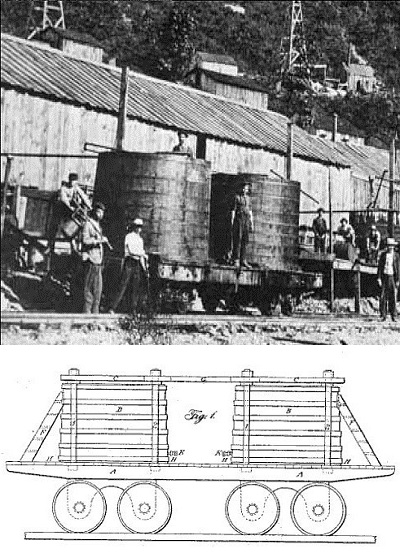
Prone to leaks and top heavy, Densmore tank cars provided a vital service, if only for a few years before single, horizontal tanks replaced them.
According to transportation historian John White Jr., the Densmore brothers’ oil tank design essentially consisted of a flat car with wooden vats attached. “The Central Pacific is known to have used such specialized cars to transport water, he noted in his 1995 book, The American Railroad Freight Car.
“However, prior to the discovery of oil by Colonel Edward (sic) Drake near Titusville, Pennsylvania, on August 27, 1859, the tank car was virtually non-existent,” added White, a former curator of Transportation at the Smithsonian Institution.
Dual Tank Design
The brothers further described the use of special bolts at the top and bottom of their tanks to act as braces and “to prevent any shock or jar to the tank from the swaying of the car while in motion.”

A Pennsylvania historical marker on U.S. 8 south of Titusville commemorates the Densmore brothers’ significant contribution to petroleum transportation technology. Dedicated in 2004, the marker notes:
The first functional railway oil tank car was invented and constructed in 1865 by James and Amos Densmore at nearby Miller Farm along Oil Creek. It consisted of two wooden tanks placed on a flat railway car; each tank held 40-45 barrels of oil. A successful test shipment was sent in September 1865 to New York City. By 1866, hundreds of tank cars were in use. The Densmore Tank Car revolutionized the bulk transportation of crude oil to market.
The benefit of such railroad cars to the early petroleum industry’s infrastructure was immense, especially as more Americans eagerly sought oil-refined kerosene for lamps.
Despite design limitations that would prove difficult to overcome, independent producers took advantage of the opportunity to transport large amounts of petroleum. Other transportation methods required teamsters taking barrels to barges on Oil Creek and the Allegheny River to get to kerosene refineries in Pittsburgh.
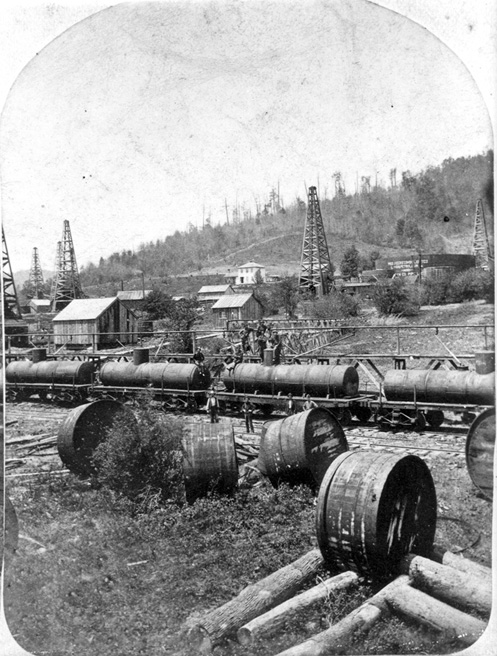
Riveted cylindrical iron tank cars replaced Densmore brothers’ wooden vat cars. Discarded Densmore tanks can be seen. Photo courtesy Drake Well Museum.
As larger refineries were constructed, it was found that it cost $170 less to ship 80 barrels of oil from Titusville to New York in a tank car instead of individual barrels. But the Densmore cars had flaws.
They were unstable, top heavy, prone to leaks, and limited in capacity by the eight-foot width of the flatcar. Within a year, oil haulers shifted from the Densmore vertical vats to larger, horizontal riveted iron cylindrical tanks, which also demonstrated greater structural integrity during derailments or collisions.

The same basic cylindrical design for transporting petroleum can be seen as modern railroads load products from corn syrup to chemicals — all in a versatile tank car that got its start in the Pennsylvania oil industry.
Oil Tanks to Typewriters
Although the Densmore brothers left the oil region by 1867 — their inventiveness was far from over. In 1875, Amos Densmore assisted Christopher Sholes to rearrange the “type writing machine” keyboard so that commonly used letters no longer collided and got stuck. The “QWERTY” arrangement vastly improved Shole’s original 1868 invention.
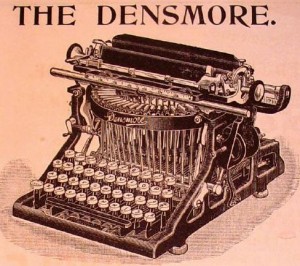
Amos Densmore helped invent one of the first practical typewriters.
Following his brother’s work with Sholes, inventor of the first practical typewriter, James Densmore’s oilfield financial success helped the brothers establish the Densmore Typewriter Company, which produced its first model in 1891. Few historians have made the oil patch to typewriter keyboard connection — including Densmore biographers.

“Biographies of the Densmores — and even their personal papers now residing at the Milwaukee Public Museum — all refer to their work on typewriters, but make no mention of their pioneering work in railroad tank car design,” notes the Pennsylvania Historical Commission.
_______________________
Recommended Reading: The American Railroad Freight Car (1995); Early Days of Oil: A Pictorial History of the Beginnings of the Industry in Pennsylvania (2000); Story of the Typewriter, 1873-1923 (2019); Myth, Legend, Reality: Edwin Laurentine Drake and the Early Oil Industry
(2000); Story of the Typewriter, 1873-1923 (2019); Myth, Legend, Reality: Edwin Laurentine Drake and the Early Oil Industry (2009). Your Amazon purchase benefits the American Oil & Gas Historical Society. As an Amazon Associate, AOGHS earns a commission from qualifying purchases.
(2009). Your Amazon purchase benefits the American Oil & Gas Historical Society. As an Amazon Associate, AOGHS earns a commission from qualifying purchases.
_______________________
The American Oil & Gas Historical Society (AOGHS) preserves U.S. petroleum history. Become an AOGHS annual supporting member and help maintain this energy education website and expand historical research. For more information, contact bawells@aoghs.org. © 2024 Bruce A. Wells. All rights reserved.
Citation Information – Article Title: “Densmore Oil Tank Cars.” Authors: B.A. Wells and K.L. Wells. Website Name: American Oil & Gas Historical Society. URL: https://aoghs.org/transportation/densmore-oil-tank-car. Last Updated: April 5, 2024. Original Published Date: April 7, 2013.
by Bruce Wells | Mar 15, 2024 | Petroleum Transportation
“No one anticipated any unusual problems as the Exxon Valdez left the Alyeska Pipeline Terminal at 9:12 p.m., Alaska Standard Time,” an account by the Alaska Oil Spill Commission would later report about the March 24, 1989, offshore disaster.
After nearly a dozen years of routine daily passages through Prince William Sound, Alaska, an oil tanker ran aground, rupturing the hull. Supertanker Exxon Valdez hit Bligh Reef and spilled more than 260,000 barrels of oil, affecting hundreds of miles of coastline. Some consider the spill amount used by Alaska’s Exxon Valdez Oil Spill Trustee Council as too conservative.

Field studies continue to examine the effects of the Exxon supertanker’s disastrous grounding on Bligh Reef in Alaska’s Prince William Sound in 1989. Photo courtesy Erik Hill, Anchorage Daily News.
A General Complacency
When the 987-foot tanker hit the reef shortly after midnight, “the system designed to carry two million barrels of North Slope oil to West Coast and Gulf Coast markets daily had worked perhaps too well,” according to the Alaska Oil Spill Commission’s initial report.
“At least partly because of the success of the Valdez tanker trade, a general complacency had come to permeate the operation and oversight of the entire system,” the commission noted. Complacency about giant oil tankers ended on March 24, 1989, when the Exxon Valdez ran aground on Bligh Reef.

“The vessel came to rest facing roughly southwest, perched across its middle on a pinnacle of Bligh Reef,” added the commission’s report. “Eight of 11 cargo tanks were punctured. Computations aboard the Exxon Valdez showed that 5.8 million gallons had gushed out of the tanker in the first three and a quarter hours.”

“Eight of 11 cargo tanks were punctured. Computations aboard the Exxon Valdez showed that 5.8 million gallons had gushed out of the tanker in the first three and a quarter hours.”
Tankers carrying North Slope crude oil had safely transited Prince William Sound more than 8,700 times during the previous 12 years. Improved shipbuilding technologies resulted in supersized vessels.
“Whereas tankers in the 1950s carried a crew of 40 to 42 to manage about 6.3 million gallons of oil…the Exxon Valdez carried a crew of 19 to transport 53 million gallons of oil,” the report explained.
Alaskan weather conditions — 33 degrees with a light rain — and the remote location added to the 1989 disaster, the report continues. With the captain not present, the third mate made a navigation error, according to another 1990 investigation by the National Transportation and Safety Board, Practices that relate to the Exxon Valdez.
“The third mate failed to properly maneuver the vessel, possibly due to fatigue or excessive workload,” the Safety Board concluded.

Containing Oil Spills
At the time, spill response capabilities to deal with the spreading oil will be found to be unexpectedly slow and woefully inadequate, according to the Oil Spill Commission.
“The worldwide capabilities of Exxon Corporation would mobilize huge quantities of equipment and personnel to respond to the spill — but not in the crucial first few hours and days when containment and cleanup efforts are at a premium,” the commission’s report explained.

At 987 feet long and 166 feet wide, the Exxon Valdez — delivered to Exxon in December 1986 — was the largest ship ever built on the West Coast.
The commission added that the U.S. Coast Guard, “would demonstrate its prowess at ship salvage, protecting crews and lightering operations, but prove utterly incapable of oil spill containment and response.”
Spill Cleanup Lessons
Exxon began a cleanup effort that included thousands of Exxon and contractor personnel, according to ExxonMobil. More than 11,000 Alaska residents and volunteers rushed to the coastline to assist.
“Because Prince William Sound contained many rocky coves where the oil collected, the decision was made to displace it with high-pressure hot water,” noted a 2001 study for the American Academy of Underwater Sciences.

“However, this also displaced and destroyed the microbial populations on the shoreline; many of these organisms (e.g. plankton) are the basis of the coastal marine food chain, and others (e.g. certain bacteria and fungi) are capable of facilitating the biodegradation of oil,” explained scientific diving expert Stephen Jewett, professor emeritus of environmental studies at the University of Alaska, Fairbanks.
“At the time, both scientific advice and public pressure was to clean everything, but since then, a much greater understanding of natural and facilitated remediation processes has developed, due somewhat in part to the opportunity presented for study by the Exxon Valdez spill.” Jewett added.
His academic paper, “Scuba techniques used to assess the effects of the Exxon Valdez oil spill,” brought insights to mitigating the impact of the Alaskan oil spill — which had expedited passage of the Oil Pollution Act of 1990.
According to ExxonMobil, the company spent $4.3 billion as a result of the accident, “including compensatory payments, cleanup payments, settlements and fines. The company voluntarily compensated more than 11,000 Alaskans and businesses within a year of the spill.”
A study conducted by the Alaska Oil Spill Commission resulted in the February 1990 report, “Details about the Accident.”
Experts have continued to review effects of the Exxon Valdez grounding on Bligh Reef; most have reported that although the ecosystem in Prince William Sound continues to recover, it is healthy.

In March 2014, a 70-page review by the National Oceanic and Atmospheric Administration (NOAA report), “Twenty-Five Years After the Exxon Valdez Oil Spill: NOAA’s Scientific Support, Monitoring, and Research,” examined the incident and NOAA’s involvement in the response, operational monitoring, and subsequent research.
Two decades before Alaska’s 1989 Exxon Valdez grounding, an oil spill from a Union Oil offshore platform six miles off the coast of Santa Barbara, California, led to the modern environmental movement — and establishment of the Environmental Protection Agency (EPA).
Learn more about the 1969 California offshore accident in Oil Seeps and Santa Barbara Spill.
_______________________
Recommended Reading: The Exxon Valdez Oil Spill, Perspectives on Modern World History (2011); Slick Policy: Environmental and Science Policy in the Aftermath of the Santa Barbara Oil Spill
(2011); Slick Policy: Environmental and Science Policy in the Aftermath of the Santa Barbara Oil Spill (2018); Amazing Pipeline Stories: How Building the Trans-Alaska Pipeline Transformed Life in America’s Last Frontier
(2018); Amazing Pipeline Stories: How Building the Trans-Alaska Pipeline Transformed Life in America’s Last Frontier (1997). Your Amazon purchase benefits the American Oil & Gas Historical Society. As an Amazon Associate, AOGHS earns a commission from qualifying purchases.
(1997). Your Amazon purchase benefits the American Oil & Gas Historical Society. As an Amazon Associate, AOGHS earns a commission from qualifying purchases.
_______________________
The American Oil & Gas Historical Society (AOGHS) preserves U.S. petroleum history. Become an AOGHS annual supporting member and help maintain this energy education website and expand historical research. For more information, contact bawells@aoghs.org. © 2024 Bruce A. Wells. All rights reserved.
Citation Information – Article Title: “Exxon Valdez Oil Spill.” Authors: B.A. Wells and K.L. Wells. Website Name: American Oil & Gas Historical Society. URL: https://aoghs.org/transportation/exxon-valdez-oil-spill. Last Updated: March 15, 2024. Original Published Date: March 24, 2009.
by Bruce Wells | Dec 21, 2023 | Petroleum Transportation
Famous New York World reporter of 1880s would take charge of Iron Clad Manufacturing Company.
She was one of the most famous journalists of her day as a reporter for the New York World. Widely known as the remarkable Nellie Bly, Elizabeth J. Cochran Seaman, investigated conditions at an infamous mental institution, made a trip around the world in less than 80 days — and manufactured the first practical 55-gallon oil drum.
The 1901 Pan-American Exposition in Buffalo, N.Y., promoted her Iron Clad Manufacturing Company as “owned exclusively by Nellie Bly – the only woman in the world personally managing industries of such magnitude.”
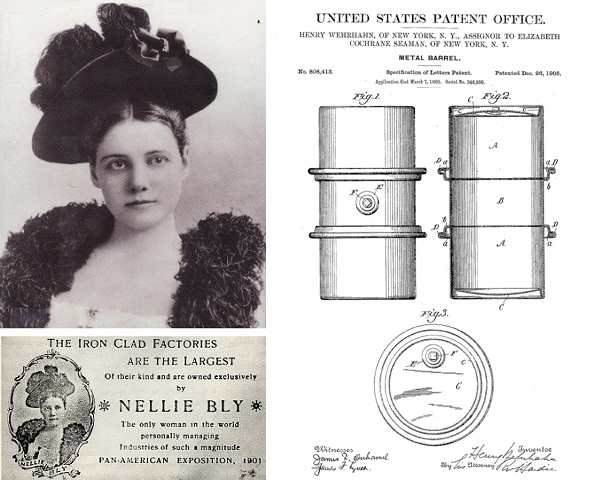
Recognizing the potential of an efficient metal barrel design, Nellie Bly acquired the 1905 patent rights from its inventor, Henry Wehrhahn, who worked at her Iron Clad Manufacturing Company.
(more…)
by Bruce Wells | Dec 1, 2023 | Petroleum Products
General Motors scientists discover anti-knock properties of tetraethyl lead gasoline in 1921.
By 1923, many American motorists would be driving into service stations nationwide and saying, “Fill ‘er up with Ethyl.”
Early internal combustion engines often suffered from a severe “knocking,” the out-of-sequence detonation of the gasoline-air mixture in a cylinder. The constant shock added to exhaust valve wear and frequently damaged engines.
Automobiles powered with gasoline had been the least popular models at the November 1900 first U.S. auto Show in New York City’s Madison Square Garden.

General Motors chemists Thomas Midgely Jr. and Charles F. Kettering tested many gasoline additives, including arsenic.
On December 9, 1921, after five years of lab work to find an additive to eliminate pre-ignition “knock” problems of gasoline, General Motors researchers Thomas Midgely Jr. and Charles Kettering discovered the anti-knock properties of tetraethyl lead.

Early experiments at GM examined the properties of knock suppressors such as bromine, iodine and tin — comparing these to new additives such as arsenic, sulfur, silicon and lead.
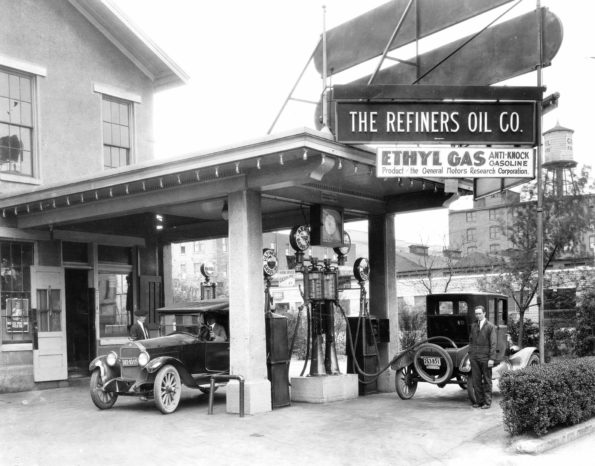
The world’s first anti-knock gasoline containing a tetra-ethyl lead compound went on sale at the Refiners Oil Company service station in Dayton, Ohio. A bolt on “Ethylizer” can be seem running vertically alongside the visible reservoir. Photo courtesy Kettering/GMI Alumni Foundation.
When the two chemists synthesized tetraethyl lead and tried it in their one-cylinder laboratory engine, the knocking abruptly disappeared. Fuel economy also improved. “Ethyl” vastly improved gasoline performance.
“Ethylizers” debut in Dayton
Although being diluted to a ratio of one part per thousand, the lead additive yielded gasoline without the loud, power-robbing knock. With other automotive scientists watching, the first car tank filled with leaded gas took place on February 2, 1923, at the Refiners Oil Company service station in Dayton, Ohio.
In the beginning, GM provided Refiners Oil Company and other service stations special equipment, simple bolt on adapters called “Ethylizers” to meter the proper proportion of the new additive.

“By the middle of this summer you will be able to purchase at approximately 30,000 filling stations in various parts of the country, a fluid that will double the efficiency of your automobile, eliminate the troublesome motor knock, and give you 100 percent greater mileage,” Popular Science Monthly reported in 1924.

By the late 1970s, public health concerns resulted in the phase-out of tetraethyl lead in gasoline, except for aviation fuel.
Anti-knock gasoline containing a tetraethyl lead compound also proved vital for aviation engines during World War II, even as danger from the lead content increasingly became apparent.
Powering Victory in World War II
Aviation fuel technology was still in its infancy in the 1930s. The properties of tetraethyl lead proved vital to the Allies during World War II. Advances in aviation fuel increased power and efficiency, resulting in the production of 100-octane aviation gasoline shortly before the war.
Phillips Petroleum – later ConocoPhillips – was involved early in aviation fuel research and had already provided high gravity gasoline for some of the first mail-carrying airplanes after World War I.

Phillips Petroleum produced tetraethyl leaded aviation fuels from high-quality oil found in Osage County, Oklahoma, oilfields.
Phillips Petroleum produced aviation fuels before it produced automotive fuels. The company’s gasoline came from the high-quality oil produced from Oklahoma’s Seminole oilfields and the 1917 Osage County oil boom.

Although the additive’s danger to public health was underestimated for decades, tetraethyl lead has remained an ingredient of 100 octane “avgas” for piston-engine aircraft.
Tetraethyl lead’s Deadly Side
Leaded gasoline was extremely dangerous from the beginning, according Deborah Blum, a Pulitzer-Prize winning science writer. “GM and Standard Oil had formed a joint company to manufacture leaded gasoline, the Ethyl Gasoline Corporation,” she noted in a January 2013 article. Research focused solely on improving the formula, not on the danger of the lead additive.
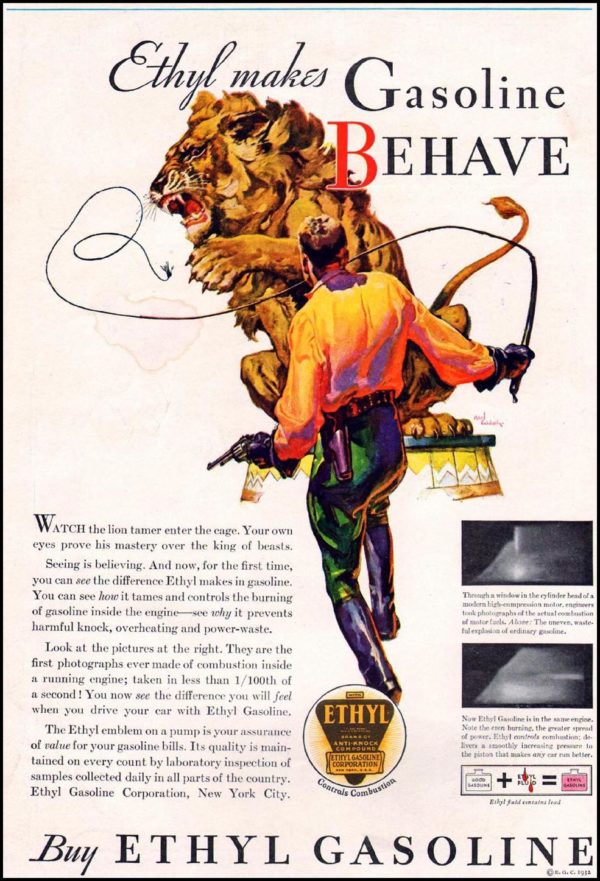
A 1932 magazine ad promoted wildly improved high-compression engine performance.
“The companies disliked and frankly avoided the lead issue,” Blum wrote in “Looney Gas and Lead Poisoning: A Short, Sad History” at Wire.com. “They’d deliberately left the word out of their new company name to avoid its negative image.”
In 1924, dozens were sickened and five employees of the Standard Oil Refinery in Bayway, New Jersey, died after they handled the new gasoline additive.
By May 1925, the U.S. Surgeon General called a national tetraethyl lead conference, Blum reported, and an investigative task force was formed. Researchers concluded there was ”no reason to prohibit the sale of leaded gasoline” as long as workers were well protected during the manufacturing process.

So great was the additive’s potential to improve engine performance, the author notes, by 1926 the federal government approved continued production and sale of leaded gasoline. “It was some fifty years later – in 1986 – that the United States formally banned lead as a gasoline additive,” Blum added.
By the early 1950s, American geochemist Clair Patterson discovered the toxicity of tetraethyl lead; phase-out of its use in gasoline began in 1976 and was completed by 1986. In 1996, EPA Administrator Carol Browner declared, “The elimination of lead from gasoline is one of the great environmental achievements of all time.”
Learn more about high-octane fuel in Flight of the Woolaroc and and early engines in Cantankerous Combustion – First U.S. Auto Show.
_______________________
Recommended Reading: An Illustrated Guide to Gas Pumps (2008); Unleaded: How Changing Our Gasoline Changed Everything (2021). Your Amazon purchase benefits the American Oil & Gas Historical Society. As an Amazon Associate, AOGHS earns a commission from qualifying purchases.
(2008); Unleaded: How Changing Our Gasoline Changed Everything (2021). Your Amazon purchase benefits the American Oil & Gas Historical Society. As an Amazon Associate, AOGHS earns a commission from qualifying purchases.
_______________________
The American Oil & Gas Historical Society (AOGHS) preserves U.S. petroleum history. Become an AOGHS annual supporting member and help maintain this energy education website, expand historical research, and extend public outreach. For annual sponsorship information, contact bawells@aoghs.org. © 2023 Bruce A. Wells. All right reserved.
Citation Information – Article Title: “Ethyl Anti-Knock Gas.” Authors: B.A. Wells and K.L. Wells. Website Name: American Oil & Gas Historical Society. URL: https://aoghs.org/products/tetraethyl-lead-gasoline. Last Updated: December 2, 2023. Original Published Date: December 7, 2014.
by Bruce Wells | Oct 28, 2023 | Petroleum Transportation
Early autos shared unpaved roads with horses and wagons.
The first U.S. Auto show opened in New York City’s Madison Square Garden in 1900, just five years after Charles Duryea claimed the first American patent for a gasoline-powered automobile. Gas proved to be the least popular source of engine power.
(more…)




(2000); Story of the Typewriter, 1873-1923 (2019); Myth, Legend, Reality: Edwin Laurentine Drake and the Early Oil Industry
(2009). Your Amazon purchase benefits the American Oil & Gas Historical Society. As an Amazon Associate, AOGHS earns a commission from qualifying purchases.











